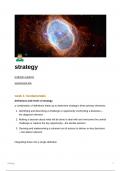strategy
textbook readings
assignment tips
week 1: fundamentals
definitions and levels of strategy
a combination of definitions leads up to determine strategy’s three primary elements:
1. Identifying and describing a challenge or opportunity confronting a business—
the diagnosis element
2. Making a decision about what will be done to deal with and overcome the central
challenge or capture the key opportunity—the decide element
3. Devising and implementing a coherent set of actions to deliver on key decisions
—the deliver element
integrating these into a single definition
strategy 1
, 💡 Strategy is a diagnosis that defines or explains a business challenge or
opportunity, a decision or set of decisions for dealing with the challenge
or opportunity, and a coherent set of actions to deliver on the decisions so
as to create sustainable advantage and superior returns.
levels
the concept is relevant at different levels of an organisation- the corporate, business
and managerial levels.
corporate-level strategy is concerned with the selection of business areas in which
the company should compete and with the development and coordination of that
portfolio of business.
relevant in diversified firms and is the focus of high-level corporate executives.
business-level strategy is about developing and sustaining a competitive
advantage in delivering an identifiable set of products and/or services.
relevant in businesses part of larger corporations or a firm with single business
providing related offerings and is the focus of business owners, entrepreneurs, and
business unit leaders in said larger corporations.
managerial-level strategic decision making involves tackling challenges and
opportunities that may have an impact on business performance. it requires two core
skills:
analytical thinking using a structured yet creative approach to work through
issues
communicating recommendations by being clear, concise and compelling
short summary table
week 2:
strategy 2
, competitive advantage
💡 if a business can produce at a lower cost than competitors, or deliver
more value than competitors, or a mix of both, it has competitive
advantage.
💡 a firm has competitive advantage when it implements a strategy that
creates superior value for its customers and that competitors are unable
to duplicate or find it too costly to try to imitate.
generic strategies to achieve competitive advantage
differentiation enables a firm to generate higher willingness to pay / command
premium price for a differentiated product
low cost production enables them to charge customers a lower price
combination of both enables a superior willingness to pay for the product that
was produced at low cost
superior returns
superior returns / above-average returns are returns in excess of what an investor
expects to earn from other investments with similar risk
measured as accounting figures such as return on assets (roa) or return on
equity (roe)
or could be measured through stock market returns
Important: many firms have other performance objectives; for instance, startups
often aim for rapid revenue growth rather than superior returns and profitability
strategic decision making
vision defines a desired future state of a firm articulating in bold terms what the
company would like to achieve
strategy 3
, mission describes what a company does or strives to do; it is a statement of
purpose
values state how people within a firm should conduct themselves, how they
should do business, and what kinds of things they should care about
these are NOT strategy. they create context for strategies to be created, evaluated,
and implemented
external environment and internal organisation
these shape a firms strategies
an effective strategy needs to align with the specifics of these things
external environment internal organisation
macro trends resources
market conditions capabilities
technology changes internal processes
industry dynamics firm-specific strengths and
weaknesses
external environment + internal organisation > strategy > competitive advantage >
superior returns
1. impact of external environment
it refers mainly aspect beyond company’s control
2a. internal organisation: resources
they are assets (things that a firm has access to) that it can draw on when
formulating and implementing a strategy
exemplary resources
tangible resources intangible resources
strategy 4
textbook readings
assignment tips
week 1: fundamentals
definitions and levels of strategy
a combination of definitions leads up to determine strategy’s three primary elements:
1. Identifying and describing a challenge or opportunity confronting a business—
the diagnosis element
2. Making a decision about what will be done to deal with and overcome the central
challenge or capture the key opportunity—the decide element
3. Devising and implementing a coherent set of actions to deliver on key decisions
—the deliver element
integrating these into a single definition
strategy 1
, 💡 Strategy is a diagnosis that defines or explains a business challenge or
opportunity, a decision or set of decisions for dealing with the challenge
or opportunity, and a coherent set of actions to deliver on the decisions so
as to create sustainable advantage and superior returns.
levels
the concept is relevant at different levels of an organisation- the corporate, business
and managerial levels.
corporate-level strategy is concerned with the selection of business areas in which
the company should compete and with the development and coordination of that
portfolio of business.
relevant in diversified firms and is the focus of high-level corporate executives.
business-level strategy is about developing and sustaining a competitive
advantage in delivering an identifiable set of products and/or services.
relevant in businesses part of larger corporations or a firm with single business
providing related offerings and is the focus of business owners, entrepreneurs, and
business unit leaders in said larger corporations.
managerial-level strategic decision making involves tackling challenges and
opportunities that may have an impact on business performance. it requires two core
skills:
analytical thinking using a structured yet creative approach to work through
issues
communicating recommendations by being clear, concise and compelling
short summary table
week 2:
strategy 2
, competitive advantage
💡 if a business can produce at a lower cost than competitors, or deliver
more value than competitors, or a mix of both, it has competitive
advantage.
💡 a firm has competitive advantage when it implements a strategy that
creates superior value for its customers and that competitors are unable
to duplicate or find it too costly to try to imitate.
generic strategies to achieve competitive advantage
differentiation enables a firm to generate higher willingness to pay / command
premium price for a differentiated product
low cost production enables them to charge customers a lower price
combination of both enables a superior willingness to pay for the product that
was produced at low cost
superior returns
superior returns / above-average returns are returns in excess of what an investor
expects to earn from other investments with similar risk
measured as accounting figures such as return on assets (roa) or return on
equity (roe)
or could be measured through stock market returns
Important: many firms have other performance objectives; for instance, startups
often aim for rapid revenue growth rather than superior returns and profitability
strategic decision making
vision defines a desired future state of a firm articulating in bold terms what the
company would like to achieve
strategy 3
, mission describes what a company does or strives to do; it is a statement of
purpose
values state how people within a firm should conduct themselves, how they
should do business, and what kinds of things they should care about
these are NOT strategy. they create context for strategies to be created, evaluated,
and implemented
external environment and internal organisation
these shape a firms strategies
an effective strategy needs to align with the specifics of these things
external environment internal organisation
macro trends resources
market conditions capabilities
technology changes internal processes
industry dynamics firm-specific strengths and
weaknesses
external environment + internal organisation > strategy > competitive advantage >
superior returns
1. impact of external environment
it refers mainly aspect beyond company’s control
2a. internal organisation: resources
they are assets (things that a firm has access to) that it can draw on when
formulating and implementing a strategy
exemplary resources
tangible resources intangible resources
strategy 4











